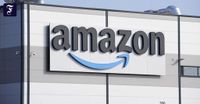Amazon has released its quarterly earnings, showcasing a revenue of $155.7 billion for the first quarter of 2025. This figure represents a 9% increase compared to the same quarter last year, which saw revenues of $143.31 billion. Analysts had anticipated a slightly lower revenue figure of $155.2 billion, making Amazon's performance a positive surprise.
One of the key drivers of this growth has been the company’s cloud division, Amazon Web Services (AWS), which reported a revenue increase of 16.9% year-on-year, reaching $29.3 billion. However, this growth was slightly below analysts' expectations of a 17.2% increase. Despite this, AWS continues to be a significant contributor to Amazon's overall success.
Amazon's operating profit also saw a notable rise, increasing from $15.31 billion in the previous year to $18.41 billion in the latest quarter. Earnings per share (EPS) were reported at $1.59, significantly higher than the $0.98 from the same quarter last year and exceeding expectations of $1.36.
However, the company’s outlook for the second quarter has raised concerns among investors. Amazon forecasted an operating profit between $13 billion and $17.5 billion, which fell short of the average analyst expectation of $17.6 billion. Consequently, in after-hours trading, Amazon's stock price dipped by 4.3%, highlighting the market's reaction to the less optimistic guidance.
Andy Jassy, Amazon's President and CEO, expressed satisfaction with the start of 2025, particularly regarding the company’s pace of innovation and commitment to enhancing customer experience. He stated, "We are very satisfied with the start to the year 2025, especially with our pace of innovation and progress in continuously improving the customer experience." Jassy pointed to several initiatives, including the launch of their first Project Kuiper satellites, which aim to provide broadband access to millions of rural households lacking connectivity.
In addition to these quarterly figures, Amazon is making substantial investments in its logistics network, particularly in rural areas of the United States. The company plans to invest over $4 billion to enhance delivery capabilities in less populated regions, aiming to create more than 100,000 new jobs. This initiative is part of Amazon's strategy to increase its delivery capacity, targeting an additional billion packages annually to areas covering the combined landmass of Alaska, California, and Texas.
Moreover, Amazon has announced a new strategic collaboration with the Pharmacy Benefit Manager Serve You Rx, which aims to provide convenient delivery of long-term medications through Amazon Pharmacy. This partnership is expected to enhance customer convenience and offer transparent pricing along with 24/7 pharmaceutical advice.
Despite the promising growth figures, the cautious outlook for the upcoming quarter has led to a mix of optimism and concern among investors. The stock market often reacts more strongly to future forecasts than to past performance, and this case appears to be no different. While Amazon’s revenue and profit growth are commendable, the company's ability to meet or exceed expectations moving forward will be crucial.
Analysts are now faced with the question of whether Amazon's strategic investments will pay off in the long run. The company’s ambitious plans to expand its logistics and healthcare services signal a commitment to growth beyond its traditional e-commerce roots, but the timing of these investments and their impact on profitability remains to be seen.
As the market digests these results, many investors are weighing their options. A new analysis released on May 2, 2025, suggests that shareholders may need to take urgent action based on the latest earnings report. With the stock under pressure from the disappointing forecast, the question remains: should investors buy, hold, or sell?
In summary, while Amazon has demonstrated strong performance in the first quarter of 2025, the subdued outlook for the second quarter has raised concerns among investors. The company’s commitment to expanding its logistics capabilities and entering the healthcare market could position it for long-term growth, but the immediate future will depend on its ability to manage expectations and deliver on its ambitious goals.





